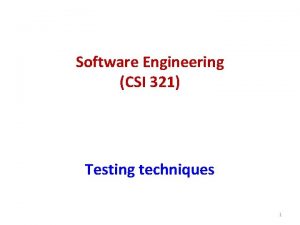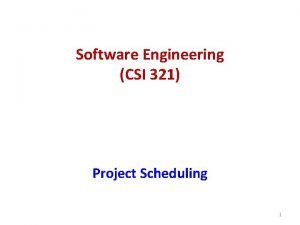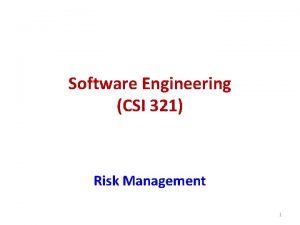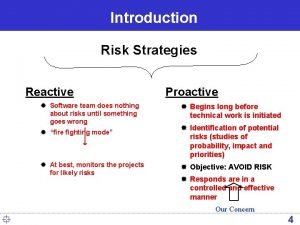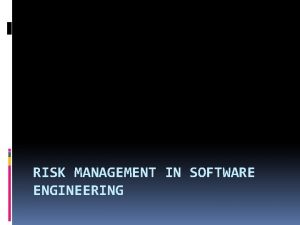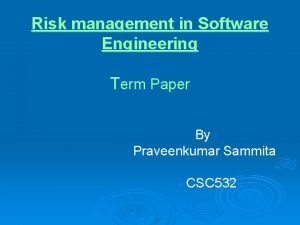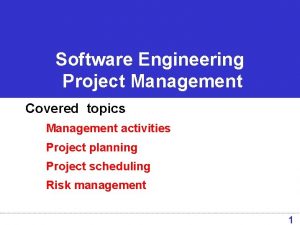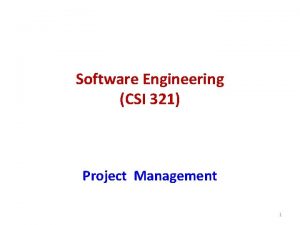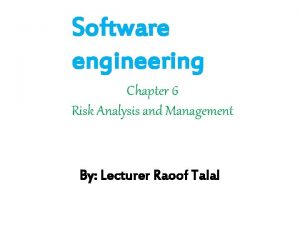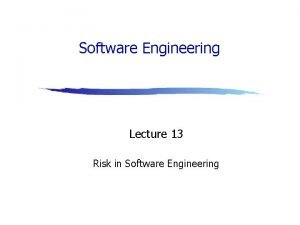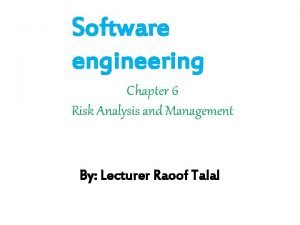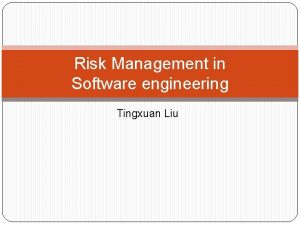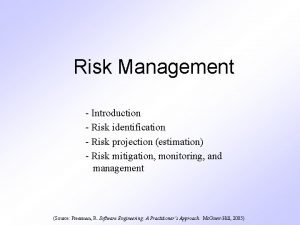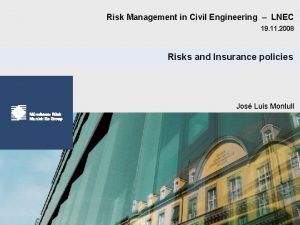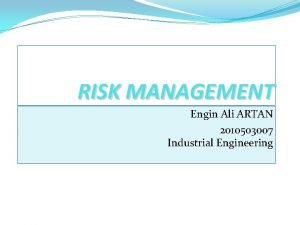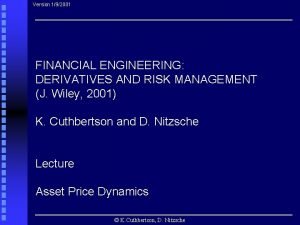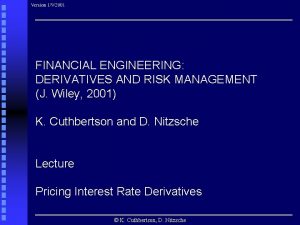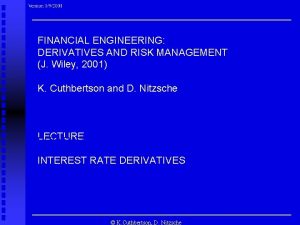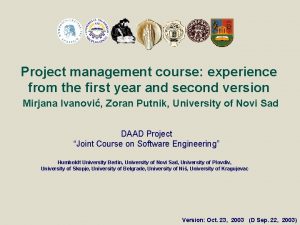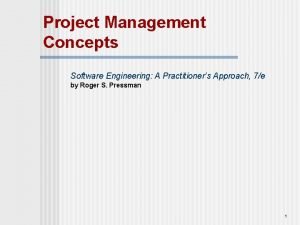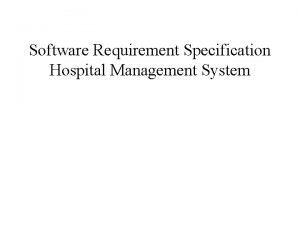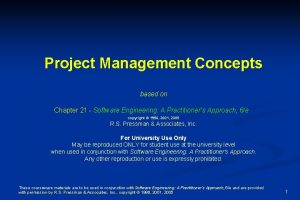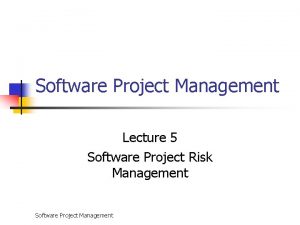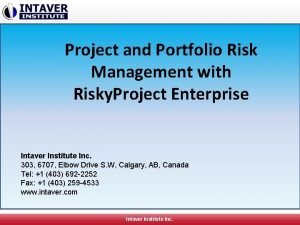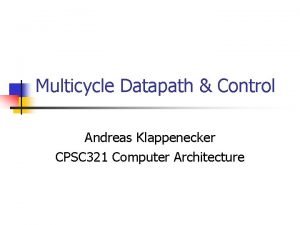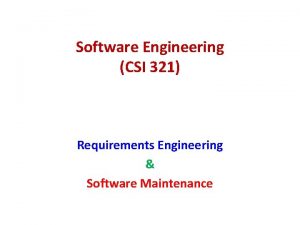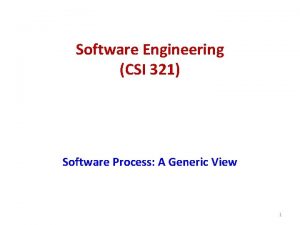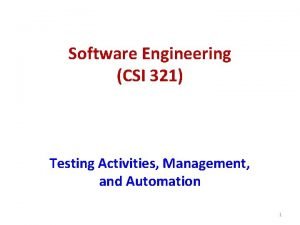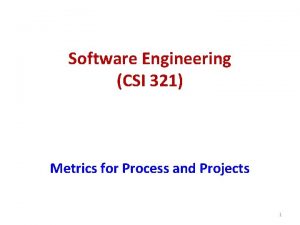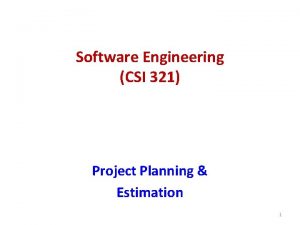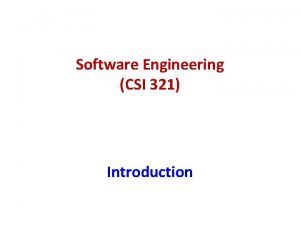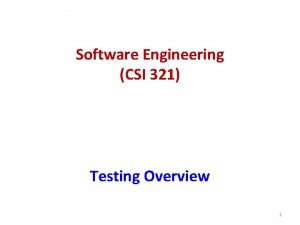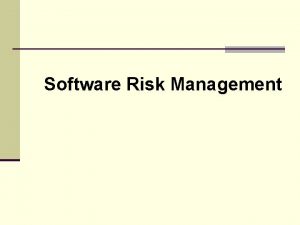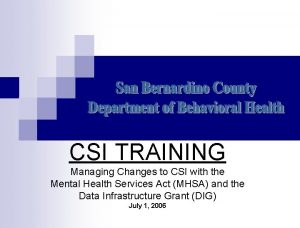Software Engineering CSI 321 Risk Management 1 Risk













































- Slides: 45

Software Engineering (CSI 321) Risk Management 1

Risk Management § Risk management is one of the main jobs of Project Manager. § Risk management is a set of actions that helps the project manager plan an approach to deal with uncertain occurrences. § It involves anticipating risks that might affect the project schedule or the quality of the software being developed and taking actions to avoid these risks. § Risk management is an emerging area that aims to address the problem of identifying and managing the risks associated with a software project. 2

Risk Management § Risk in a project is the possibility that the defined goals are not met. It is the inability to achieve objectives within defined cost, schedule, and technical constraints. § Most projects have risks, especially the big projects. § Risk management is the area that tries to ensure that the impact of risks is minimal on – – Cost – Quality – Schedule 3

Why is Risk Management important? • History of software development is full of major & minor failures (Because risks were not identified & managed properly). – Projects run over budget – Behind schedule – Some abandoned midway • Any project can encounter uncertainties in the form of increased costs, schedule delays, and diminished qualities. Unless tackled, these uncertainties can lead to major project disasters. • Software is a difficult undertaking. Lots of things can go wrong. Understanding the risks and taking proactive measures to avoid or manage them –is a key element of good software project management. 4

Risk Management • • What can go wrong? What is the likelihood? What will the damage be? What can we do about it? 5

Risk Management Process § What are the steps in Risk Management Process? , or § What are the major activities/tasks of a project manager in risk management? 1) Risk Identification –possible risks are identified 2) Risk Analysis –risks are analyzed to determine the likelihood and the damage/consequences. Risks are ranked by probability & impact. 3) Risk Planning –A plan is developed to manage the risks with high probability & high impact. 4) Risk Monitoring –Risk is constantly assessed & plans for risk mitigation are revised. 6

Characterizing Risk § Risk concerns the future happenings – What risks might cause software project to go awry? What can we do today to avoid problems tomorrow? § Risk involves change – How will changes affect timeliness & overall success? – What aspects of the problem domain and solution are unstable? § Risk involves choice & uncertainty – What methods & tools should we use? How many people should be involved? How much emphasis on quality is “enough”? We often make decisions based on incomplete information. § RISK, like DEATH, is one of the few certainties of life. 7

Risk Strategies : Reactive vs. Proactive § Reactive Risk Management: – Laughingly called “Indiana Jones school of risk management” – Risk management ==> Crisis management (“fire-fighting mode”) – Project team reacts to risks when they occur – Software team does nothing about risks until something goes wrong, then the team flies into action in an attempt to correct the problem rapidly(this is called “fire-fighting mode”). When this fails, “crisis management” takes over and the project is in real jeopardy. 8

Risk Strategies : Reactive vs. Proactive § Proactive Risk Management: – A considerably more intelligent strategy for risk management – Identify potential risks in advance – Assess probability and impact – Prioritize the risks by importance – Establish explicit risk management plan – But “Risk is unavoidable”( not all risks can be avoided), so contingency plan is developed 9

Software Risks § Software risk always involves two characteristics – 1) Uncertainty –the risk may or may not happen; there are no 100% probable risks. 2) Loss –If the risk becomes a reality, unwanted consequences or losses will occur. 10

Software Risks • When risks are analyzed, it is important to – – Quantify the level of uncertainty – The degree of loss associated with each risk – Consider different categories of risks 11

Categories of Risks § What are the categories of risks encountered as software is built? – Project risks – Product risks – Technical risks – Business risks – Known risks – Predictable risks – Unpredictable risks • Note that these risk types may overlap. 12

Project Risks § Project risks threaten the project plan. If risks become real, then – Project schedule will slip – Costs will increase § Project risks affect the project schedule or resources. § Project risks identify potential budgetary, schedule, personnel, resource, stakeholder and requirements problems and their impact on a software project. § Examples: Experienced staff will leave the project before it is finished, Essential hardware for the project will not be delivered on time, There will be a change of organizational management with different priorities. 13

Product Risks • Product risks are risks that affect the quality or performance of the software being developed. • An example might be the failure of a purchased component to perform as expected. • Other examples – Size underestimate, Requirement change, CASE tool underperformance 14

Technical Risks • Threaten quality and timeliness of the software to be produced. If a technical risk becomes a reality, implementation may become difficult/impossible. • Technical risks identify potential design, implementation, interface, verification and maintenance problems. • Other risk factors: specification ambiguity, technical uncertainty, technical obsolescence, “leading-edge” technology. 15

Technical Risks • Technical risks occur because the problem is harder to solve than we thought it would be. – – – – Is the technology new to you? New algorithms ? Interface with new/unproven HW/SW/DB? Specialized user interface? New analysis, design, testing methods? Unconventional development methods? Excessive performance constraints? Customer uncertain about feasibility? 16

Business Risks § Business risks threaten the viability of the software to be built. § Business risks often jeopardize the project or the product. § Business risks affect the organization development or procuring the software. § Top five business risks – 1) No market for product (market risk) 2) Product no longer fits in the business plan (strategic risk) 3) Sales force doesn’t know how to sell the product (sales risk) 4) Loss of management support (management risk) 5) Losing budgetary or personnel commitment (budget risk) 17

Known Risks • Uncovered after careful evaluation of the project plan, the business & technical environment in which the project is being developed and other reliable information sources. • Examples – Unrealistic delivery date – Lack of documented requirements – Lack of software scope – Poor development environment 18

Predictable Risks • Predictable risks are extrapolated from past project experience. • Examples – Staff turnover – Poor customer communication 19

Unpredictable Risks • Extremely difficult to identify in advance • They can and do occur 20

Seven Principles Of Risk Management 1) Maintain a global perspective—View software risks within the context of system and the business problem 2) Take a forward-looking view—Think about the risks that may arise in the future; Establish contingency plans so that future events are manageable 3) Encourage open communication—If someone states a potential risk, don’t discount it. 4) Integrate—A consideration of risk must be integrated into the software process. 21

Seven Principles Of Risk Management 5) Emphasize a continuous process—The team must be vigilant throughout the software process, modifying identified risks as more information is known and adding new ones as better insight is achieved. 6) Develop a shared product vision—If all stakeholders share the same vision of the software, it likely that better risk identification and assessment will occur. 7) Encourage teamwork—The talents, skills and knowledge of all stakeholder should be pooled when risk management activities are conducted. 22

Risk Management Paradigm Control Track RISK Identify Plan Analyze 23

Risk Identification • Risk identification is a systematic attempt to specify threats to the project plan ( estimates, schedule, resource loading etc. ) • By identifying known & predictable risks, the project manager takes a first step toward – – avoiding them when possible – controlling them when necessary 24

Risk Identification • There are two distinct types of risks for each of the categories we discussed 1) Generic risks – are a potential threat to every software project. 2) Product-specific risks – Can be identified only by those with a clear understanding of the technology, the people, and the environment that is specific to the software to be built – To identify product-specific risks, the project plan & statement of scope are examined 25

Risk Identification Method § One method for identifying risks is to create a risk item checklist. • The checklist can be used for risk identification and focuses on some subset of known & predictable risks in the following generic subcategories: 1) Product size—Risks associated with the overall size of the software to be built or modified. 2) Business impact—Risks associated with constraints imposed by management or the marketplace. 3) Customer characteristics—Risks associated with the sophistication of the customer and the developer's ability to communicate with the customer in a timely manner. 26

Risk Identification 4) Process definition—Risks associated with the degree to which the software process has been defined and is followed by the development organization. 5) Development environment—Risks associated with the availability and quality of the tools to be used to build the product. 6) Technology to be built—Risks associated with the complexity of the system to be built and the "newness" of the technology that is packaged by the system. 7) Staff size and experience—Risks associated with the overall technical and project experience of the software engineers who will do the work. 27

Assessing Overall Project Risk-I § Is the current software project at serious risk? • Have top software and customer managers formally committed to support the project? • Are end-users enthusiastically committed to the project and the product to be built? • Are requirements fully understood by the software engineering team and their customers? • Have customers been involved fully in the definition of requirements? • Do end-users have realistic expectations? 28

Assessing Overall Project Risk-II • Is project scope stable? • Does the software engineering team have the right mix of skills? • Are project requirements stable? • Does the project team have experience with the technology to be implemented? • Is the number of people on the project team adequate to do the job? • Do all customer/user constituencies agree on the importance of the project and on the requirements for the product to be built? 29

Risk Components & Impacts • Performance risk—the degree of uncertainty that the product will meet its requirements and be fit for its intended use. • Cost risk—the degree of uncertainty that the project budget will be maintained. • Support risk—the degree of uncertainty that the resultant software will be easy to correct, adapt, and enhance. • Schedule risk—the degree of uncertainty that the project schedule will be maintained and that the product will be delivered on time. § Impact Category: Negligible, Marginal, Critical, Catastrophic 30

Impact Assessment 31

Risk Estimation/Projection • Risk projection, also called risk estimation, attempts to rate each risk in two ways – The likelihood or probability that the risk is real – The consequences of the problems associated with the risk, should it occur. 32

Risk Estimation/Projection • There are four risk projection steps: 1) Establish a scale that reflects the perceived likelihood of a risk 2) Delineate the consequences of the risk 3) Estimate the impact of the risk on the project and the product 4) Note the overall accuracy of the risk projection (to avoid misunderstandings). 33

Developing a Risk Table • A Risk Table provides a project manager with a simple technique for risk projection – Estimate the probability of occurrence – Estimate the impact on the project on a scale of 1 to 4, where 4 = Negligible/low impact on project success 3 = Marginal impact on project success 2 = Critical impact on project success 1 = Catastrophic impact on project success – Sort the table by probability and impact 34

Developing a Risk Table A Risk Table provides a project manager with a simple technique for risk projection PS – project size risk BU – business risk 35

Assessing Risk Impact q How do we assess the consequences of a risk? • Three factors affect the consequences that are likely if a risk does occur: 1) It’s nature-indicates the problems that are likely 2) Scope- Severity & its overall distribution 3) Timing- When & for how long the impact will be felt 36

Risk Exposure (Impact) • The overall risk exposure, RE, is determined using the following relationship : RE = P x C , where – P is the probability of occurrence for a risk – C is the cost to the project should the risk occur • Risk exposure can be computed for each risk in the Risk Table, once an estimate of the cost of the risk is made. • Total risk exposure for all risks can provide a means for adjusting the final cost estimate for a project. • Note: If RE > 50% of Project Cost, viability of the project must be reevaluated. 37

Risk Exposure: An Example • Risk identification. Only 70 percent of the software components scheduled for reuse will, in fact, be integrated into the application. The remaining functionality will have to be custom developed. • Risk probability. 80% (likely). • Risk impact. 60 reusable software components were planned. If only 70 percent can be used, 18 components would have to be developed from scratch (in addition to other custom software that has been scheduled for development). Since the average component is 100 LOC and local data indicate that the software engineering cost for each LOC is $14. 00, The overall cost (impact) to develop the components would be, 18 x 100 x 14 = $25, 200 • Risk exposure. RE = 0. 80 x 25, 200 ~ $20, 200. 38

Risk Mitigation, Monitoring, and Management • Mitigation—How can we avoid the risk? • Monitoring—What factors can we track that will enable us to determine if the risk is becoming more or less likely? • Management—What contingency plans do we have if the risk becomes a reality? 39

The RMMM plan • Risk management strategy can be included in the software project plan or the risk management steps can be organized into a separate RMMM plan. § The RMMM plan (Risk Mitigation, Monitoring and Management plan): – Documents all work performed as part of risk analysis – Used by Project Manager as part of the overall project plan 40

The RMMM plan • Risk mitigation – Problem avoidance activity – Proactive planning for risk avoidance 41

The RMMM plan § Risk monitoring • Project tracking activity with three primary objectives – 1. Assessing whether predicted risks occur or not 2. Ensuring risk aversion steps are being properly applied 3. Collect information for future risk analysis • Determining what risk(s) caused which problems throughout the project 42

The RMMM plan • It is important to note that RMMM steps incur additional project cost. • Project planner performs a classic cost/benefit analysis. • Adapt Pareto rule(80– 20 rule) to software risks: – 80% of the overall project risk can be accounted for by only 20% of the identified risks. – Work performed during earlier risk analysis steps will help the planner to determine which of the risks reside in that 20% • The RMMM Plan needs to be tracked & updated regularly. 43

Risk Information Sheets § RIS (Risk Information Sheet) • Instead of developing a formal RMMM plan, some software teams use RIS. • In RIS, each risk is documented individually. • In most cases, the RIS is maintained using a database system. • RIS components: – – – risk id, date, probability, impact, description refinement, mitigation/monitoring management/contingency plan/trigger current status originator, assigned staff member 44

Risk Management • “If you know the enemy and know yourself, You need NOT fear the result of a hundred Battles. ” Sun Tzu ( Chinese General) • For the software project manager, The enemy is RISK! 45
 Csi 321
Csi 321 What is project scheduling in software engineering
What is project scheduling in software engineering Csi-321 introduction to computing applications
Csi-321 introduction to computing applications Risk management planning in software engineering
Risk management planning in software engineering Systematic attempt to specify threats to project plan
Systematic attempt to specify threats to project plan Risk management software engineering
Risk management software engineering Risk management in software engineering
Risk management in software engineering Software project management activities
Software project management activities System architecture example
System architecture example Forward engineering in software engineering
Forward engineering in software engineering Csi in project management
Csi in project management Risk table in software engineering
Risk table in software engineering What is risk projection in software engineering
What is risk projection in software engineering Types of risk in software engineering
Types of risk in software engineering Risk analysis in software engineering
Risk analysis in software engineering Risk exposure in software engineering
Risk exposure in software engineering Projected risk
Projected risk Market risk assessment
Market risk assessment Software maintenance in software engineering ppt
Software maintenance in software engineering ppt Who invented software engineering
Who invented software engineering What is software metrics in software engineering
What is software metrics in software engineering Example of software crisis
Example of software crisis Software metrics example
Software metrics example Real time software design in software engineering
Real time software design in software engineering Software design fundamentals in software engineering
Software design fundamentals in software engineering Civil engineering risk management
Civil engineering risk management Risk management in industrial engineering
Risk management in industrial engineering Financial engineering derivatives and risk management
Financial engineering derivatives and risk management Financial engineering derivatives and risk management
Financial engineering derivatives and risk management Financial engineering derivatives and risk management
Financial engineering derivatives and risk management 4 ps of project management
4 ps of project management Project management tools in software engineering
Project management tools in software engineering 4 p's of project management in software engineering
4 p's of project management in software engineering Hospital management system software engineering
Hospital management system software engineering What is management myths in software engineering
What is management myths in software engineering 4 p's of project management in software engineering
4 p's of project management in software engineering Key risk indicators financial risk management
Key risk indicators financial risk management Risk map
Risk map Software project risk
Software project risk Project and portfolio risk management software
Project and portfolio risk management software Edel 321
Edel 321 321 vs 338 fiduciary
321 vs 338 fiduciary 132 213
132 213 Apokalypsis 321
Apokalypsis 321 Oam 321
Oam 321 Andreas klappenecker
Andreas klappenecker
